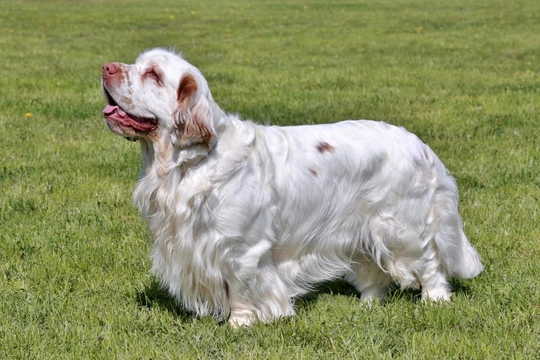
Pyruvate Dehydrogenase Phosphates 1 Deficiency (PDP-1) in spaniels
Pyruvate dehydrogenase phosphates 1 deficiency, known as PDP-1 for short, is a hereditary health condition that can affect the Clumber spaniel and the Sussex spaniel dog breeds, and that is an acute condition that leads to a combination of a very high intolerance for exercise, and common incidences of post-exercise collapse. The condition can potentially be misdiagnosed as exercise induced collapse, another hereditary health condition that shares some common symptoms with PDP-1.
The condition leads to a failure of the PDH complex, which is a necessary part of the bodily systems that help to eliminate waste products from the body through metabolism. When the PDH complex fails or is ineffective, affected dogs will be unable to exercise normally without suffering from fast onset and very extreme exhaustion, and also potentially, post-exercise collapse.
Ultimately, the condition can be fatal, often at a young age. However, the onset of the acute symptoms of the condition may not become apparent until affected puppies have gone on to their new homes, and when they begin training and being walked on the lead after their vaccinations.
Pyruvate dehydrogenase phosphates 1 deficiency is not contagious, and the only way that dogs can develop the condition is by means of inheriting the right combination of mutated genes from their two parent dogs that leads to the affected form of the condition.
Some dogs of the Clumber spaniel and Sussex spaniel breeds may carry the condition and be able to pass it on to their offspring without actually being affected by the condition themselves.
In order to reduce the spread of the condition across the wider gene pools of affected breeds, The Kennel Club oversees a testing scheme for the condition, which allows would-be breeders to find out the status of their dogs before breeding, to ensure that only healthy dogs are used.
Testing also gives puppy buyers additional peace of mind when it comes to knowing more about the hereditary health of the dog that they may be considering buying.
In this article, we will look at pyruvate dehydrogenase phosphates 1 deficiency in dogs in more detail, including how the heredity of the condition works, and how to get your dog tested. Read on to learn more.
More about pyruvate dehydrogenase phosphates 1 deficiency
Pyruvate dehydrogenase phosphates 1 deficiency can pose a significant risk to both the Clumber spaniel and Sussex spaniel breeds as a whole, because both breeds are fairly uncommon and as such, have a limited number of genetically diverse dogs within the potential breeding pool.
This means that hereditary health conditions such as pyruvate dehydrogenase phosphates 1 deficiency are more likely to spread within the breed than it would in breeds with much larger dog populations, such as the Labrador retriever.
At one point, around 25% of all Clumber spaniels in a sample testing group were found to have either the affected form of the condition or be a carrier for it, which is why testing prior to breeding is so important.
What sort of dogs can be affected by the condition?
Pyruvate dehydrogenase phosphates 1 deficiency has been identified in the Clumber spaniel and Sussex spaniel dog breeds, both of which are relatively small breeds and have been included within The Kennel Club’s vulnerable native breeds database.
This means that while the condition is not a danger to other breeds, the relatively small gene pools of viable breeding stock from the Clumber spaniel and Sussex spaniel breeds means that a significant number of dogs of these breeds may carry the condition, and this makes it challenging to eradicate.
Dogs that are cross-bred with one Sussex spaniel or Clumber spaniel parent may inherit one copy of the gene mutation necessary to cause the condition, but unless the other parent dog is also a carrier, they will not be affected themselves.
However, a Sussex spaniel crossed with a Clumber spaniel without pre-breeding testing will run the same theoretical risk of inheriting the condition as a pedigree dog from either of the two respective breeds.
How does the heredity of the condition work?
Pyruvate dehydrogenase phosphates 1 deficiency is an autosomal recessive health condition, which means that the status of both parent dogs combined is what dictates the status of their puppies, which is described as either clear, carrier or affected.
- Two clear dogs will have a clear litter.
- Two affected dogs will have an affected litter.
- Two carriers will have 50% carriers, 25% affected and 25% clear.
- A clear dog and an affected dog will have a litter of carriers.
- A clear dog and a carrier will have 50% clear and 50% carrier puppies.
- A carrier and an affected dog will have 50% carriers and 50% affected.
Because carriers are not affected by the condition themselves, it is generally perceived as acceptable to breed dogs that will potentially produce carrier puppies, as the gene pools of the two breeds are small enough that breeding only clear dogs may increase the risk of causing a prevalence of other hereditary health conditions, because of the small population of potential breeding stock dogs.
How to get your dog tested and identify their status
In order to find out your dog’s status, all you need to do is ask your vet to take a DNA sample from your dog, which is then sent off to one of The Kennel Club’s approved laboratories for testing, and they will then return the result to you.



